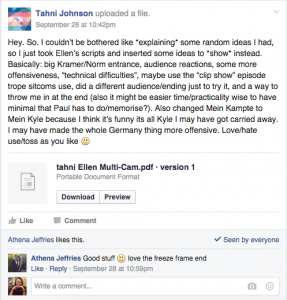With our mockumentary shot and edited to a rough cut, and a script ready for our stoner circle scene, this week I began writing a script for our final experiment; the live-audience, multi-cam sitcom.
We knew that this was going to be our hardest scene to shoot, but I didn’t want to limit my writing, so I didn’t take much care for logistics when writing. Writing the scene, I was primarily focused on making it seem like a multi-cam show. I was conscious of writing for a laugh track, as well as for a simplistic set. The jokes had to be simple, the type that are almost lowest common denominator, or would be at home in an episode of Friends or The Big Bang Theory.
My first draft of this script was just over a page in length. It was basically five jokes, one after the other. These weren’t very funny jokes, but they were the kind that would work in a PG rated, 6pm syndicated, unfunny sitcom. The second draft was lengthier, with jokes that were longer than one-liners, and slightly more intelligent (though still not great).
While the main focus of the script was on the group members, we were also experimenting with the comedy format, so I brought the live audience to the forefront. I wanted to do this in a way that was not simply just making the TV viewing audience aware of the live audience. I didn’t want to simply incorporate a shot of an audience or a voice-over stating their presence. Instead, I wrote the script to be based around the group presenting in front of a group of people, with one character sitting in the audience to ‘measure audience satisfaction’. This is my favourite aspect of the second script; it breaks the fourth wall, but it also adds to the narrative and comedy of the scene.
After finishing this draft of the script, I posted it to Facebook to get feedback from the group. I also encouraged them to edit it and re-draft it.
Tahni pretty much took my script and made it work logistically for us. There’s no way we would be able to get a big enough group of people to form a ‘live audience’, and we couldn’t guarantee we could shoot Paul’s shots on the same day as our own. Tahni also lengthened some of the jokes, and made them more like the sort of jokes that would appear on a good sitcom, like Seinfeld (I know that good/bad sitcoms are a matter of opinion but I’m going to keep referring to Seinfeld as a good example and the Big Bang Theory as a bad example).
This is my original script, with Tahni’s changes tracked in red.
This is where I think this studio worked how it was supposed to. Tahni, as a creative writing student, took my work and made it better. We discussed the changes and I was able to see where improvements were made. I still got to write, and I got to explore my ideas, but I also got to collaborate with a writer. The end result may not have been great, but the process helped me to explore script-writing in relation to the media I am passionate about.
